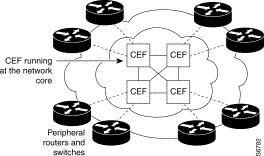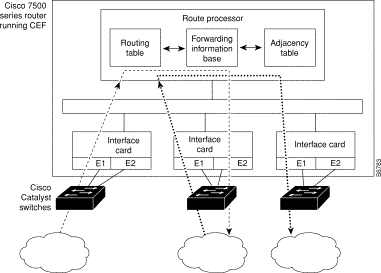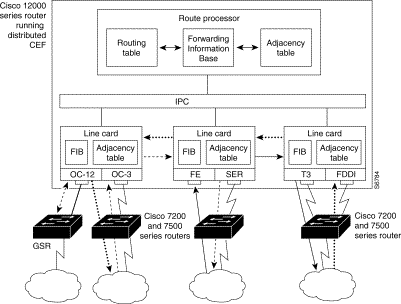
Cisco Express Forwarding (CEF) is advanced Layer 3 IP switching technology. CEF optimizes network performance and scalability for networks with large and dynamic traffic patterns, such as the Internet, on networks characterized by intensive Web-based applications, or interactive sessions.
CEF offers these benefits:
Although you can use CEF in any part of a network, it is designed for high-performance, highly resilient Layer 3 IP backbone switching. For example, Figure 8 shows CEF being run on Cisco 12000 series Gigabit Switch Routers (GSRs) at aggregation points at the core of a network where traffic levels are dense and performance is critical.

In a typical high-capacity internet service provider environment, Cisco 12012 GSRs as aggregation devices at the core of the network support links to Cisco 7500 series routers or other feeder devices. CEF in these platforms at the network core provides the performance and scalability needed to respond to continued growth and steadily increasing network traffic. CEF is a distributed switching mechanism that scales linearly with the number of interface cards and bandwidth installed in the router.
Information conventionally stored in a route cache is stored in several data structures for CEF switching. The data structures provide optimized lookup for efficient packet forwarding. The two main components of CEF operation are the
CEF uses a Forwarding Information Base (FIB) to make IP destination prefix-based switching decisions. The FIB is conceptually similar to a routing table or information base. It maintains a mirror image of the forwarding information contained in the IP routing table. When routing or topology changes occur in the network, the IP routing table is updated, and those changes are reflected in the FIB. The FIB maintains next-hop address information based on the information in the IP routing table.
Because there is a one-to-one correlation between FIB entries and routing table entries, the FIB contains all known routes and eliminates the need for route cache maintenance that is associated with earlier switching paths such as fast switching and optimum switching.
Network nodes in the network are said to be adjacent if they can reach each other with a single hop across a link layer. In addition to the FIB, CEF uses adjacency tables to prepend Layer 2 addressing information. The adjacency table maintains Layer 2 next-hop addresses for all FIB entries.
The adjacency table is populated as adjacencies are discovered. Each time an adjacency entry is created (such as through the ARP protocol), a link-layer header for that adjacent node is precomputed and stored in the adjacency table. Once a route is determined, it points to a next hop and corresponding adjacency entry. It is subsequently used for encapsulation during CEF switching of packets.
A route might have several paths to a destination prefix, such as when a router is configured for simultaneous load balancing and redundancy. For each resolved path, a pointer is added for the adjacency corresponding to the next-hop interface for that path. This mechanism is used for load balancing across several paths.
In addition to adjacencies associated with next-hop interfaces (host-route adjacencies), other types of adjacencies are used to expedite switching when certain exception conditions exist. When the prefix is defined, prefixes requiring exception processing are cached with one of the special adjacencies listed in Table 4.
| This adjacency type... | Receives this processing... |
|---|---|
|
Null adjacency |
Packets destined for a Null0 interface are dropped. This can be used as an effective form of access filtering. |
|
Glean adjacency |
When a router is connected directly to several hosts, the FIB table on the router maintains a prefix for the subnet rather than for the individual host prefixes. The subnet prefix point to a glean adjacency. When packets need to be forwarded to a specific host, the adjacency database is gleaned for the specific prefix. |
|
Punt adjacency |
Features that require special handling or features that are not yet supported in conjunction with CEF switching paths are forwarded to the next switching layer for handling. Features that are not supported are forwarded to the next higher switching level. |
|
Discard adjacency |
Packets are discarded. This type of adjacency occurs only on the Cisco 12000 series routers. |
|
Drop adjacency |
Packets are dropped, but the prefix is checked. |
When a link-layer header is prepended to packets, FIB requires the prepend to point to an adjacency corresponding to the next hop. If an adjacency was created by FIB and not discovered through a mechanism, such as ARP, the Layer 2 addressing information is not known and the adjacency is considered incomplete. Once the Layer 2 information is known, the packet is forwarded to the route processor, and the adjacency is determined through ARP.
CEF currently supports ATM/AAL5snap, ATM/AAL5mux, ATM/AAL5nlpid, Frame Relay, Ethernet, FDDI, PPP, HDLC, and tunnels.
CEF can be enabled in one of two modes:
When CEF mode is enabled, the CEF FIB and adjacency tables reside on the route processor, and the route processor performs the express forwarding. You can use CEF mode when line cards are not available for CEF switching or when you need to use features not compatible with distributed CEF switching.
Figure 9 shows the relationship between the routing table, FIB, and adjacency table during CEF mode.

Figure 9 shows Cisco Catalyst switches forwarding traffic from workgroup LANs to a Cisco 7500 series router on the enterprise backbone running Cisco Express Forwarding. The route processor performs the express forwarding.
When distributed CEF (dCEF) is enabled, line cards, such as VIP line cards or Gigabit Switch Router (GSR) line cards, maintain an identical copy of the FIB and adjacency tables. The line cards perform the express forwarding between port adapters, relieving the RSP of involvement in the switching operation.
dCEF uses an Inter Process Communication (IPC) mechanism to ensure synchronization of FIBs and adjacency tables on the route processor and line cards.
Figure 10 shows the relationship between the route processor and line cards when dCEF mode is active.

In this Cisco 12000 series router the line cards perform the switching. In other routers where you can mix various types of cards in the same router, it is possible that not all of the cards you are using support CEF. When a line card that does not support CEF receives a packet, the line card forwards the packet to the next higher switching layer (the route processor) or forwards the packet to the next hop for processing. This structure allows legacy interface processors to exist in the router with newer interface processors.
In addition to configuring CEF and dCEF, you can also configure these features:
See the next chapter, Configuring Cisco Express Forwarding, for information on enabling these features.